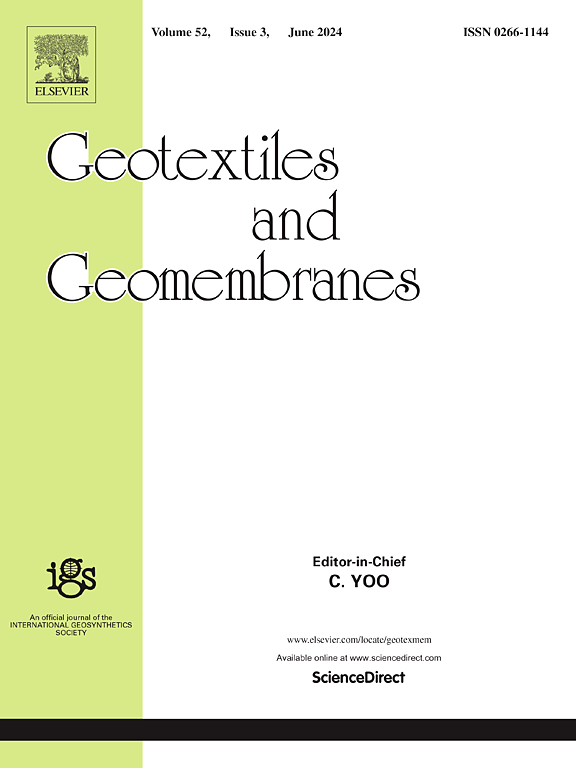非连续发酵情况下土工织物的生物堵塞问题
IF 6.2
1区 工程技术
Q1 ENGINEERING, GEOLOGICAL
引用次数: 0
摘要
本文介绍了生物堵塞对用于垃圾填埋场过滤和排水工程的土工织物水力性能的影响。在使用天然渗滤液和营养液进行不连续发酵的情况下,对有纺和无纺土工织物试样进行了堵塞测试。通过实验测量不同土工织物试样在不同浸泡时间下的横面水导率和浸渍率的变化,评估了生物堵塞的后果。然后利用 Kozeny-Carman 方程根据水力传导结果反向计算孔隙率的降低。此外,还评估了抗生素和抗真菌溶液对生物膜发展的影响。结果表明,随着浸泡时间的延长,单位面积上的生物量积累越多,土工织物试样的横面水力传导率就越低。使用抗生素和抗真菌溶液后,编织土工织物和无纺土工织物的孔隙率恢复了 90% 以上,水导率恢复了 78% 至 83%。这些结果表明,堵塞主要是由于生物活性造成的。尽管在测量和定义方面存在一定的局限性,但事实证明浸渍率是评估生物堵塞的一个可靠参数。本文章由计算机程序翻译,如有差异,请以英文原文为准。
Biological clogging of geotextiles under discontinuous fermentation scenario
This article presents the effect of biological clogging on the hydraulic performance of geotextiles used for the construction of filter and drainage in landfills. Clogging tests were performed on specimens of woven and non-woven geotextiles in a discontinuous fermentation scenario using natural leachate and a nutrient solution. The consequences of biological clogging were assessed through experimental measurements of changes in the cross-plane hydraulic conductivity and the impregnation ratio of different geotextiles specimens at different immersion times. Porosity reduction was then back-calculated from the hydraulic conductivity results using the Kozeny-Carman equation. Additionally, the impact of an antibiotic and antifungal solution on biofilm development was evaluated. It was demonstrated that the cross-plane hydraulic conductivity of geotextile specimens decreases as biomass accumulation per unit area increases with immersion time. The application of an antibiotic and antifungal solution resulted in a porosity recovery of over 90% and a hydraulic conductivity recovery ranging from 78 to 83% for both woven and non-woven geotextiles. These results demonstrate that the clogging was primarily due to biological activity. Despite certain limitations in measurement and definition, the impregnation ratio proved to be a reliable parameter for the evaluation of biological clogging.
求助全文
通过发布文献求助,成功后即可免费获取论文全文。
去求助
来源期刊

Geotextiles and Geomembranes
地学-地球科学综合
CiteScore
9.50
自引率
21.20%
发文量
111
审稿时长
59 days
期刊介绍:
The range of products and their applications has expanded rapidly over the last decade with geotextiles and geomembranes being specified world wide. This rapid growth is paralleled by a virtual explosion of technology. Current reference books and even manufacturers' sponsored publications tend to date very quickly and the need for a vehicle to bring together and discuss the growing body of technology now available has become evident.
Geotextiles and Geomembranes fills this need and provides a forum for the dissemination of information amongst research workers, designers, users and manufacturers. By providing a growing fund of information the journal increases general awareness, prompts further research and assists in the establishment of international codes and regulations.
 求助内容:
求助内容: 应助结果提醒方式:
应助结果提醒方式:


